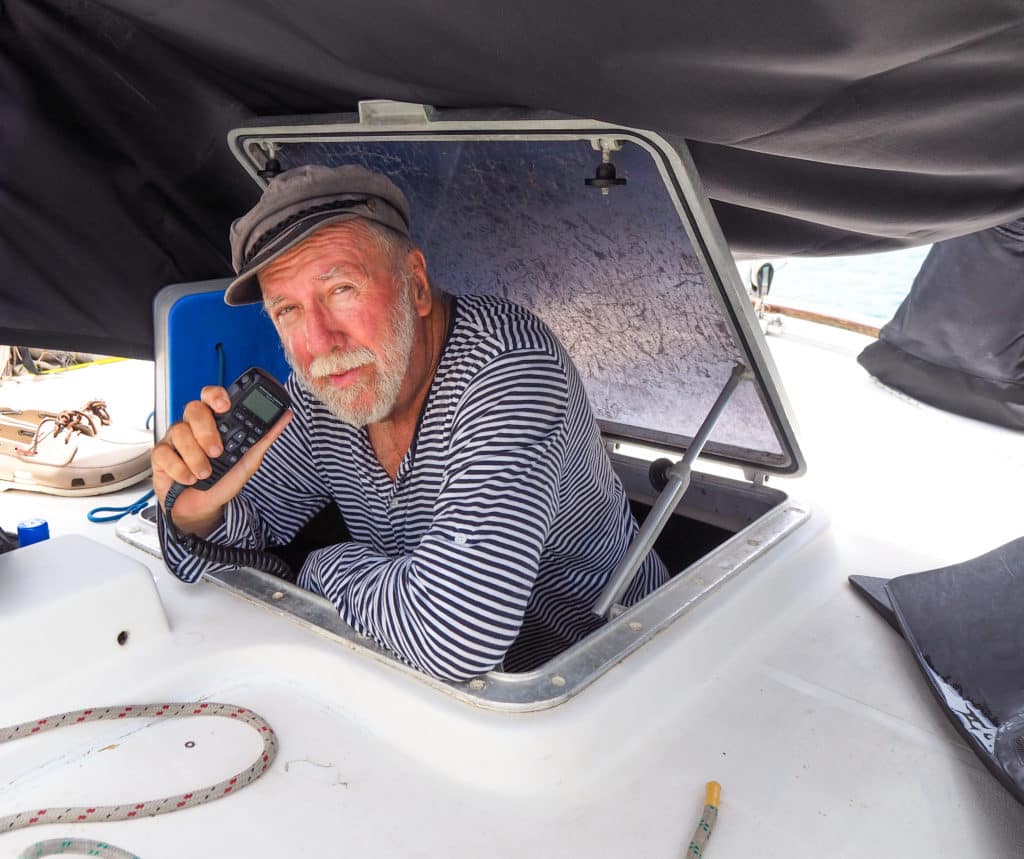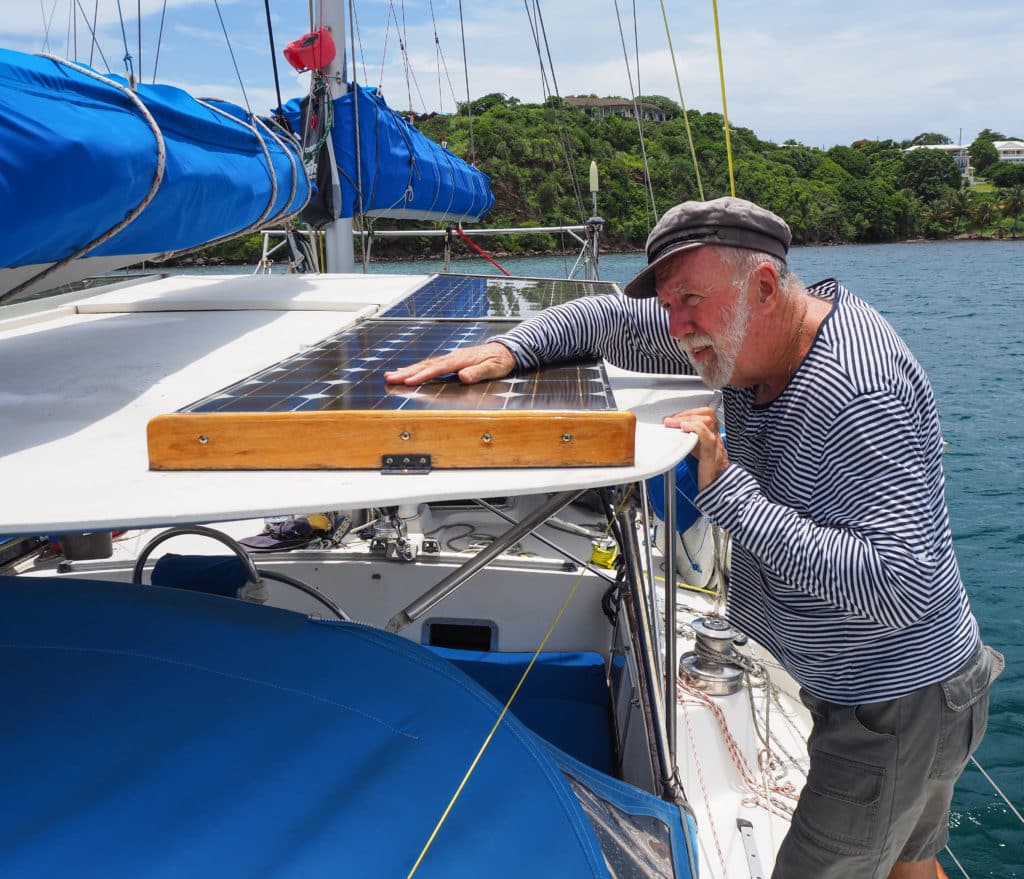
Growing up aboard the 1924 wooden schooner Elizabeth in the 1950s was a trip: We had canvas sails of Egyptian cotton, a tarred manila anchor rode, a mechanical windlass, a well-swung compass, a calibrated chronometer, a cherished sextant and kerosene running lights. I’ll never forget the time my father brought me on a tour of one of the sailboats he was delivering to South America and pointed out that it had two switchable batteries! Why in hell anyone would want two batteries aboard a sailboat was beyond us.
I write this more than 50 years later, on a boat with 12 6-volt Trojan T-105 batteries in my bilge. I used to carry a rigging knife with a marlinespike on my belt. Now I can whip out my digital multimeter from the same location. Yes, I’ve seen some changes, a very mixed bag of changes. And during the witnessing, I’ve come to realize that progress is a double-edged sword.
Let’s glance at onboard watermakers, for example. When Carolyn and I started cruising offshore in the late 1960s, these were unheard of aboard a small sailing vessel. Then, as the units grew more common and dependable, they seemed only a plus. But as soon as your average circumnavigating craft possessed one, your average marina stopped using water as a way to lure you to its fuel dock. Thus, many shoreside facilities that had clean fresh water for boats simply stopped providing it, and at the same time, those few that kept the flow going realized they now had an increasingly rare and precious commodity, and started charging accordingly. A few even began charging, by the quarter-hour, a dockage fee while you took on water. Suddenly fresh water was hard to find for the cruising vessel. It’s ironic that the widespread use of watermakers caused the devices to come into wider use!
Let’s stay with the watermakers for illustrative purposes a moment longer.
About 15 to 20 years ago, watermakers really came into their own by dramatically decreasing in size and increasing in dependability. Still, these early robust desalinators owned you as much as you owned them. I started hearing people say, “Oh, I can’t. I have a watermaker,” meaning they didn’t want to pickle their unit to avoid problems, so they didn’t want to go up a river, into a certain bay or to a dock because of the bad water quality. Thus, a mechanical device purchased to free you from the land sharks started to compromise and limit your cruising itinerary. Strange!
At the same time, some marinas simply said, “Our water is for our customers.” That meant you now had to overnight at the marina if you wanted water, and overnighting can be very expensive compared to a weekly or monthly charge. Thus, the transient cruiser had better bring a pocketful of gold if he wants a glass of semiclear water. (At the pricey Bali Marina, the fresh water comes out with clumps of seaweed and wiggling worms, and has the faint odor and sheen of sulfurous gasoline.) Pocket cruisers fare the worst. They are too small to have watermakers, and their crews often can’t afford them. But alas, many marinas that desire to attract the profitable megayachts now have adopted a policy that states, “Sure, small boats are welcome — with a minimum charge of 45 feet.” Yikes!
And then there’s the case of modern cruisers who have spent their lifetime earning enough to afford their vessel, and who aren’t as mechanically inclined as their forefathers were. Thus, simplicity of use has become a real selling point. Highly dependable watermakers started marketing set-it-and-forget-it back-flushing units — and rapidly became so complicated that you can barely find the watermaker buried in the electronics. So what we now have are sailors circumnavigating aboard small-tankage vessels that have freshwater washdown pumps and even freshwater heads!
I’m often asked a simple question: “Should I buy a watermaker before crossing the Pacific?” My long and rambling answer seldom satisfies. The condensed version is this: Yes, buy a simple one, if you can afford it, but if you can’t, go anyway. I’ve circumnavigated twice without one and once with. It’s a mixed bag.
Now here are a few more conundrums to consider.
I personally hate bow thrusters — two potentially deadly holes in the hull, a giant increase in drag, lots of weight forward that increases hobbyhorsing and a million complicated seals to leak. But marinas are shrinking as bow thrusters come into widespread use. I’ve recently been assigned slips that were impossible to get into without one. Unfortunately, Ganesh, our 43-foot, 30,000-pound Wauquiez ketch requires a football field to turn around. We used to occasionally see couples in their 80s cruising offshore in very basic vessels. We marveled at their ability to crank their sheet winches at such an advanced age. Now we see older couples offshore with electric sheet winches. They get so little exercise it is difficult for them to fend off another vessel as they drag through the harbor.
While I’m in favor of having free email aboard via ham radio (and inexpensive email via SailMail), I have no desire to have an Internet connection while offshore. Many cruisers end up spending as much money to surf the Internet at sea as frugal sailors do on their entire circumnavigation.
Each to his own, I guess. Sure, I love our single-sideband radio and Pactor digital modem because they allow me to talk to all the boats around me, but I have no use for a satellite phone that expensively prevents me from doing exactly that. Security offshore is an issue, especially because we’ve repeatedly crossed the Sulu Sea, Malacca Straits and South China Sea, as well as cruised the Gulf of Aden off Somalia. One cruiser I know wanted to be sure he was well-armed before heading out across the dreaded Indian Ocean. Thus he attempted to purchase an AK-47 in Thailand, a criminal act for which he went to jail for five years. (Yes, security against Somali pirates was excellent in the Big House.)
One of the questions I ask myself when purchasing an expensive marine item (actually, during any major life decision) is: Does this make me more free or less free? Basically, I want a simple and robust boat that is capable of going to sea at a moment’s notice. The problem is that the concept of simple varies from one individual to the next. For instance, I never want a boat with air conditioning or a generator, yet I have many dear friends here in the tropics who would not consider living aboard without both.

Air-conditioned boats, of course, spend 99 percent of their time in marinas, with their temperature-sensitive owners held prisoner inside in morgue-like conditions. Many of them don’t even know their next-boat neighbor, whom they seldom meet in passing. Only occasionally do they leave the dock and go anchor out. And even then, they sit indoors, hiding inside and polluting the anchorage with diesel fumes and engine noise. Interested? Not me.
Contrast this with a non-air-conditioned sailboat. My wife, Carolyn, and I eat the vast majority of our meals outside in the cockpit, in full view of our many cruising friends with whom we are constantly interacting. People passing in dinghies stop by to chat. Our seven silent solar cells provide all our renewable energy. We don’t give off any noise or pollution — only self-sustaining and nonpolluting good vibes.
One of the coolest (sorry for the pun) aspects of living aboard (air-conditioned or not) is that there is no right way to do it. We have wonderful friends on engineless 24-foot sailing vessels and just as wonderful friends on 74-foot Deerfoots with all the conveniences.
My purpose here isn’t to claim my way is the right way, but rather that all ways have advantages and disadvantages.
For example, my wife, daughter and I lived aboard Wild Card, a Hughes 38, from 1989 to 1995 without an engine. We cruised the entire Caribbean, including northern South America, without a problem. However, after installing a Perkins M30 diesel, we found our cruising life vastly improved. True, having no engine freed us of the expense and time of diesel maintenance, but it came at the added inconvenience of making many harbors off-limits to us. In essence, we didn’t need an engine to move our vessel over vast distances offshore, only to fully enjoy the harbors within sight of us.
For us, having an engine was more of a lifestyle choice than a navigational one.
Ditto for our dinghy propulsion. On Elizabeth, Carlotta and Corina, the first three cruising boats I was involved with, I rowed our tender. However, as our family grew, I aged and our ability to anchor cheaply pushed us to more challenging locations in more remote areas, the distances to shore became too great. We used a 2 or 5 hp engine during all our circumnavigations. The motors were small enough to be easily lifted and yet powerful enough to push a loaded dinghy against a major squall. While living aboard in the Virgin Islands, our dinghy acts as our car. Just recently, I purchased a 10 hp Tohatsu so Carolyn and I can plane off between St. John, St. Thomas, Jost Van Dyke and Tortola. This saves us vast amounts of time and money, and has no drawback in terms of weight because we rarely remove the engine from the tender. In spring 2018, when we leave on circumnavigation number four, we will probably trade it in for a 5 hp Yamaha.
Each form of power was the right choice at the time: rowing when I was young and the distances were short, a small outboard while actively cruising and a slightly larger, more powerful model for living aboard and interisland transport. Of course, all my dinghies have been set up to be easily brought aboard, ever since my father told me to “tow any dinghy you don’t mind losing.”
The bottom line is that the cruising lifestyle is infinitely customizable, but everything is a compromise and interrelated. Figuring out your own right answers is part of the fun.
– – –
Fatty and Carolyn plan to weather hurricane season in Grenada this year.








